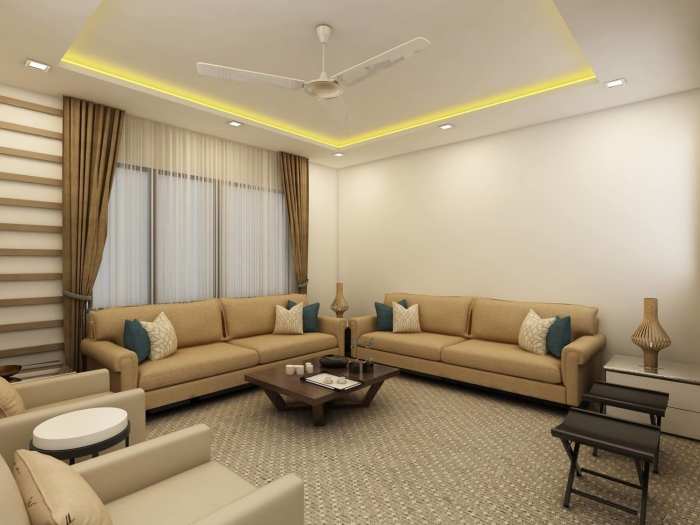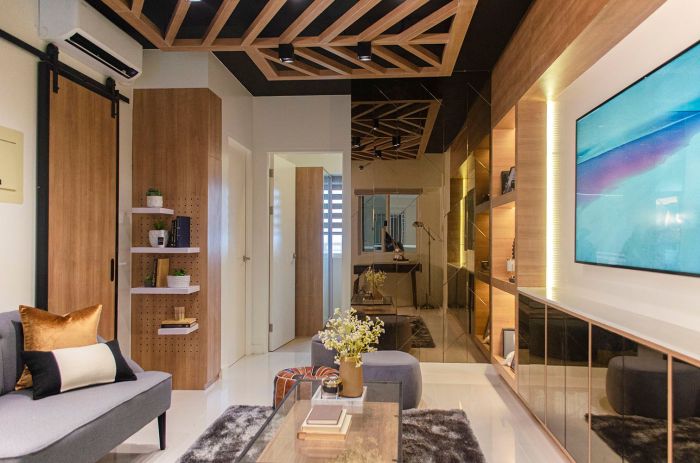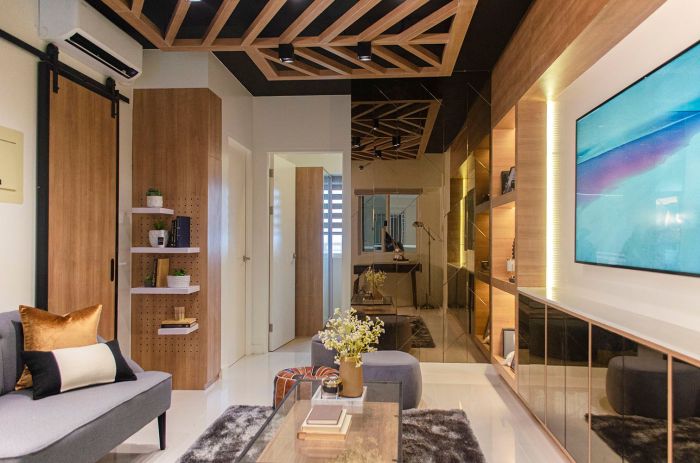Ceiling interior design for small houses sets the stage for this enthralling narrative, offering readers a glimpse into a story that is rich in detail and brimming with originality from the outset. Small houses present unique challenges for interior design, particularly when it comes to the ceiling.
Limited space, low ceilings, and a potential for feeling cramped can make it difficult to create a visually appealing and functional environment. However, with a little creativity and ingenuity, it is possible to transform a small house ceiling into a design masterpiece, maximizing space, enhancing aesthetics, and creating a sense of openness and grandeur.
This comprehensive guide delves into the intricacies of ceiling design for small houses, exploring a range of techniques and strategies that can elevate the overall design and functionality of these cozy abodes. From maximizing space and light with strategic design elements to incorporating functional elements and enhancing visual appeal with various finishes, this guide provides practical insights and inspirational ideas for homeowners looking to create a truly captivating and inviting space.
Incorporating Personal Style and Preferences

Your ceiling is an integral part of your home’s overall design, and in a small house, it can significantly impact the feeling of space and coziness. Don’t overlook the opportunity to express your unique personality and taste through your ceiling design.
Ceiling design in a small house can be a challenge, but using light colors and reflective surfaces can create a sense of spaciousness. For larger homes, like a 3 storey house interior design , you can experiment with more elaborate ceiling designs, such as exposed beams or vaulted ceilings.
However, even in a small space, a well-designed ceiling can make a big difference in the overall feel of the room.
Creating a Unique Ceiling, Ceiling interior design for small house
Your ceiling should be a reflection of your personal style. It’s an excellent opportunity to showcase your individual preferences and create a space that feels uniquely yours. Whether you lean towards a minimalist aesthetic, a touch of vintage charm, or a vibrant pop of color, your ceiling can be a canvas for your creative vision.
A simple, light-colored ceiling can make a small house feel more spacious, especially when paired with a bright color scheme. You can even mimic the breezy, relaxed vibe of a california beach house interior design by incorporating natural wood beams or a textured, whitewashed finish.
Ultimately, the ceiling is a key element in creating a cohesive and welcoming atmosphere in any small home.
- Color:The color of your ceiling can dramatically impact the overall ambiance of your room. A light and airy color can make a small space feel larger, while a bolder hue can add a touch of drama. Experiment with different shades and tones to find the perfect match for your style.
While ceiling design in a small house often focuses on maximizing space and light, a three-story home allows for more creative freedom. You can incorporate dramatic architectural elements like vaulted ceilings or exposed beams, creating a sense of grandeur. For inspiration on how to design a stunning three-story home, check out this article on 3 story house interior design.
Back in the realm of smaller spaces, consider using lighter colors and reflective surfaces on your ceilings to enhance the feeling of spaciousness.
- Materials:From traditional drywall to more contemporary options like wood paneling or exposed beams, the material you choose for your ceiling can add texture, visual interest, and even acoustic benefits. Consider your personal preferences and the overall style of your home when making this decision.
- Lighting:Lighting plays a crucial role in creating the right atmosphere. Choose light fixtures that complement your ceiling design and provide the desired level of illumination. A chandelier can add a touch of elegance, while recessed lighting can create a sleek and modern look.
Epilogue

In conclusion, ceiling interior design for small houses is a multifaceted endeavor that requires a blend of creativity, practicality, and a keen eye for detail. By embracing the principles Artikeld in this guide, homeowners can transform their small house ceilings into stunning focal points, maximizing space, enhancing aesthetics, and creating a sense of openness and grandeur.
Whether incorporating sustainable and budget-friendly solutions or integrating personal style and preferences, the possibilities for creating a unique and captivating ceiling design are endless. So, embark on this design journey with confidence and let your creativity soar, transforming your small house ceiling into a testament to your individual style and vision.
FAQ Guide: Ceiling Interior Design For Small House
What are some common mistakes to avoid when designing a small house ceiling?
Avoid using dark colors, heavy materials, and overly ornate designs that can make the space feel smaller and more cluttered. Opt for lighter colors, reflective surfaces, and simple, streamlined designs that enhance the sense of openness and spaciousness.
How can I make my small house ceiling feel taller?
Utilize vertical elements such as stripes, tall furniture, and strategically placed mirrors to create an illusion of height. Consider using a vaulted ceiling or incorporating recessed lighting to further enhance the sense of verticality.
What are some budget-friendly ceiling design options for small houses?
Consider painting the ceiling a light color, using budget-friendly materials like wallpaper or textured plaster, or incorporating DIY projects like installing crown molding or adding a simple accent ceiling.
How can I integrate my personal style into my small house ceiling design?
Express your individuality through color choices, material selection, and incorporating design elements that reflect your personal taste. For example, you could use bold colors, unique textures, or incorporate elements of your favorite design style.




